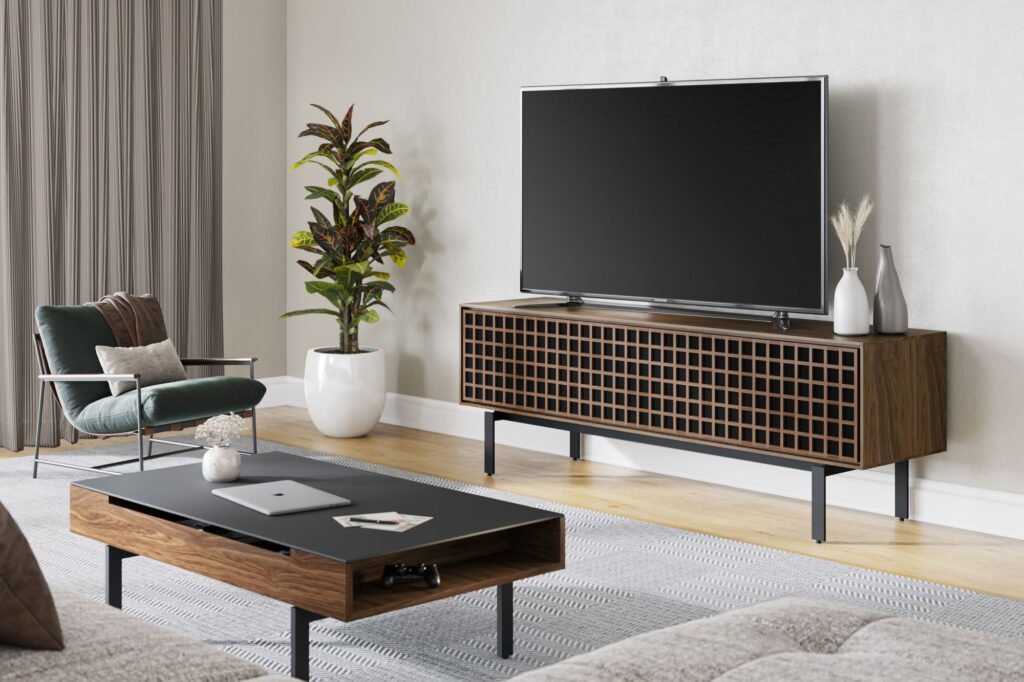

Gone are the days of wall-sized entertainment centers. Thanks to flat-screen TVs, online music streaming and sound bars, most of us store our electronics in media cabinets.
For a fraction of the size of an entertainment center, a media cabinet gives your TV a solid place to sit or hang above. Inside, it has ample space to store audio and video equipment, gaming consoles and other accessories. As the central location for all things entertainment, the media cabinet serves as the hub of any media or family room. Media cabinets come in a variety of sizes and finishes to suit all tastes and entertainment needs. The perfect media cabinet depends on your equipment, room, and lifestyle. Does your home have a dedicated media room? Do you have an open floor plan with a multifunctional living area? Are you half of a cozy couple or head of a family of five?
Whether you need a spot for the TV or you’re designing a full-blown home theater, follow these guidelines to select a functional-yet-stylish media cabinet for your home.
TV size plays a key role in which media cabinet you choose. John Milk, Texas Regional Manager at Copenhagen, says TVs look best when there’s at least a couple inches of cabinet to either side. The same rule applies if you hang your TV on the wall. “Imagine the TV as a piece of art,” he says. “You want the media cabinet to be size appropriate.” The series of Corridor media cabinets by BDI, for example, is available in two, three, or four door models to ensure that you can find the best proportioned console without sacrificing style. The height of the TV also determines the size of your media cabinet. If you place your TV on the cabinet, make sure it sits high enough for easy viewing.
Take stock of all your electronics: sound bar, gaming console, streaming console, DVD/CD player, surround sound receiver, and more. Make sure your media cabinet has enough storage to discretely conceal these items. You may also want to allow for a couple open spaces, providing space for your system to grow.
If you have an extensive music and movie collection, consider storing those in a nearby closet. Speakers may sit on stands at the sides of the room or you may have them installed in the ceiling, depending on your equipment.
Certain models, such as BDI’s Sector Media Console, have a sound bar or speaker shelf paired with acoustic-friendly doors for proper sound dispersion. Rear access panels and wire management features allow you to engineer your dream setup, while also leaving space for storing gaming equipment, remotes and other odds and ends.
Media cabinets come in multiple wood finishes, as well as steel and other materials. Milk says walnut is always a popular choice, as it blends with both contemporary and more traditional décor. He’s also seeing a lot of grey and charcoal stain on wood, which complements the greys and taupes that are popular in today’s interior design. For a cool, neutral look, the satin white or fog grey matte finish of the Tanami media and storage console brings a unique, contemporary vibe.
Minimalist patterns in steel and wood suit contemporary and modern decor. BDI’s Elements cabinet has an ultra-contemporary design with geometric laser-cut doors, a minimalist metal base, and advanced features.
If you have small children and rambunctious dogs, you may not want a scratch-prone high-gloss cabinet. However, you don’t have to completely forego the contemporary look.
Select BDI media cabinets feature black satin-etched glass surfaces that resist scratching. If you accidentally scratch the glass, simply buff it out with a melamine foam sponge.
Media cabinets come with features to assist in discrete storage as well as installation and sound quality. Many cabinets like the Interval come with adjustable shelves that you can configure as your system needs change. When you do have to add or change a piece of equipment, features such as integrated wire management, easy-access back panels, and wheels allow you to set up and update your media center easily.
Safety straps secure your TV, preventing unwanted accidents and injuries. Strategic cutouts on the bottom, back and within the shelves allow heat from components to escape, keeping your equipment cool. Even shelf pins have purpose. Instead of pegs that may vibrate, BDI cabinets use vibration-damping shelf pins to secure adjustable shelves. When the volume kicks up, the pins don’t make noise.
When deciding where to place your media cabinet, consider who will be watching TV and from where. You want the TV positioned just above eye level to avoid neck strain. To make sure everyone gets the best seat in the house, you may consider a curved sofa, which saves space and allows for optimal viewing.
Will you put your media cabinet against a main wall or in a corner? Corner cabinets or models that swivel work well in small spaces. As your home entertainment equipment becomes more advanced, make sure your media cabinet has a solid foundation. High-quality media stands not only look great, but also contain features to enhance the hub of your home.
To browse a wide selection of media cabinets and to configure your home entertainment setup with other living room essentials, visit Copenhagen in Tucson, Phoenix, Gilbert, or Scottsdale, Arizona, or San Antonio, Austin, and El Paso, Texas. Or, shop online at CopenhagenLiving.com